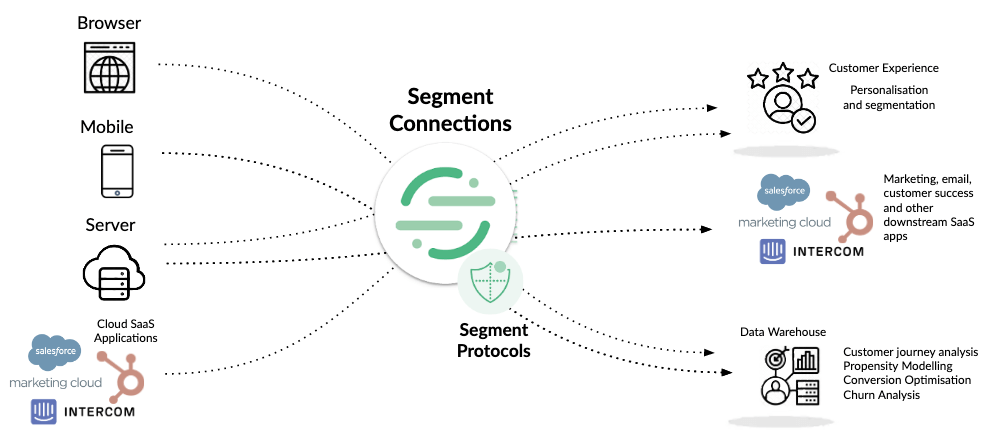Here’s How Claravine and CDPs like Segment Work Together

We often get asked the question about how Claravine compares to customer data platforms like Segment. It’s a great question and here is how we answer the question:
First, what is a CDP?
Customer Data Platforms (aka CDPs) are all the rage and have been for a few years. Yet, to many, there is a lack of clarity as to the common features and functionality of each. I know this intimately because I was hired to write a CDP requirements template and the document turned out to be 8 categories, 22 sub-categories, and 169 specific requirements – short of the crazy templates many research firms put together but to evaluate that many variables alone are a daunting task. Unfortunately, I cannot share that document because it’s IP is owned by someone else.
Considering the above, what’s a basic definition of a customer data platform? My definition would be “software that consumes data from a variety of sources to create a comprehensive and consistent customer profile.”
So, what is Claravine if it’s not a CDP?
Claravine is a data platform that helps standardize, govern, and connect data across every team, system, and channel. This ensures consistent standards and optimal digital experiences across the enterprise. Much of this data Claravine supports is digital marketing data like content, campaign, catalogs, and coupons. The data managed in Claravine is not personally identifiable information (PII) nor are we an analytics platform.
Instead, think of us as a hub that feeds your digital experiences (e.g. Adobe Experience Manager), execution platforms (e.g. Google Campaign Manager), and analytics tools (e.g. Adobe Analytics) the right data for strong business performance. Hundreds of top brands use Claravine to centralize their content and campaign data structures, governing the process to generate, validate, and connect data.
How does Claravine differ from CDPs?
I am going to reference Segment specifically here because it’s a great example of a CDP. Where Segment is like a bridge between Sources and Destinations (as they call them), Claravine makes sure the data flowing to and from Segment is already of high quality. If you’re familiar with Segment at all, you’ve likely seen the “Tracking Plan” (link). This is like a schema for your event and property data. The data Segment consumes comes from your apps, on your websites, your databases, and other 3rd party technologies. You’re not creating data in Segment, you’re creating the framework and rules for the data that passes through Segment.

Alternatively, high volumes of data are created or managed (or both) directly in Claravine. Yes, there are plenty of integrations to certain platforms that import and bi-directionally sync data (e.g. our new Adobe Experience Manager integration) in and out of Claravine for manual review and updates.
CDPs have a similar environment – integrations from a variety of sources where the data flows but users are not generally editing such data because it may be a risk to the integrity of the data. Claravine protects from data quality risk by using our technology to enforce standards and governance on the data creation process.
How we differ is while Segment is tracking events and properties, companies that use Claravine are creating quality data that Segment is looking for. In the case of digital campaigns, Segment may look for specific campaign properties when someone engages with your site or app and capture that. In the case of content, Segment uses site metadata for event properties. End users are creating a lot of this data (often in Claravine) before Segment captures it. We enrich the data flowing into Segment (and other CDPs) by creating standards and rules for the data that needs to be published and available.
Because of the above, Claravine very much complements CDPs and their mission for a comprehensive and consistent customer data profile. The reality is that a CDP is just one piece of the tech stack puzzle that Claravine enriches. The data our customers create and manage within Claravine engulfs the entirety of their marketing and adtech stack, from execution platforms to analytics systems.

Where we overlap?
Claravine and other CDPs have governance and standardization functionality including data validation and violation alerts. However, the overlap kind of stops there. And the data we’re validating is different. Claravine validates data integrity during the creation process AND has ongoing monitoring (e.g. of marketing tags). CDPs, namely Segment, have violation detection and even blocking of event data flow.
Additionally, Segment has a function called Protocols that makes sense of the data it actively receives whereas we provide standardization and governance before the data is generated for Segment. Both are data standardization processes but done at different stages. (We’d like to think ours makes more sense because it’s proactive vs. reactive).
Keep in mind that Segment prefaces the use of blocking data flow with this key statement:
“IMPORTANT: It’s critical that you feel confident about the quality of your data before you enable blocking. This is a serious step that you should only do after you have resolved any violations that appear when you first connect a Tracking Plan to a Source.” (Source)
Conclusion
Overall, there is little shared functionality between a solution like Claravine and CDPs like Segment. The data imported, created, and pushed out within Claravine is then used by Segment in a totally different way, consumed from owned digital experiences, and sent to other execution, analytics, and database applications.
Segment is only as good as the data it receives and the features don’t work if they don’t have data. Claravine helps to make sure that Segment is receiving correct data which is generated by all of the teams across your organization so you can get the benefits of Segment immediately, trusting the data rather than hoping you’re getting the right data. Claravine is the foundation for data integrity within your CDP, ensuring the data created across channels is consistent and clean at its inception.



